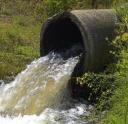 As I mentioned in my previous post on this topic, the as-passed version of the amendments to the Water Pollution Prevention and Control Law assesses penalties for “intentional,” i.e. not accidental, exceedances of discharge standards based on a multiple of the applicable “discharge fee” (up to a maximum of 5x this amount). The comment draft applied a range of set fines for intentional exceedances (up to maximum of RMB1,000,000). I have given up trying to determine which penalty type is actually tougher on polluters because there is not enough available information to construct a justifiable typical case for purposes of comparison. A crucial issue is how to treat chronic over-standard dischargers. In China this will first involve an issue of proof. Since “continuous monitoring” is only now starting to be employed in some of the more environmentally progressive areas, the fact is that most wastewater dischargers to receiving streams are not required either to sample or report on a daily basis their flows or pollutant loads or concentrations. At best, at the start up of plant operations they measured flow and pollutant loadings and their discharge fees were based on that data (another question: if I reported over-limit discharges at plant start up and have been paying the prescribed feed for these discharges, can I now be penalized for them? I assume not, but the law is not clear on this point). So, let’s assume the local EPB inspectors show up at the plant, take samples, estimate daily flow rates, and determine that a facility is exceeding discharge limits, does the plant get fined only for the exceedances occurring on that day, or is an assumption made the plant has been exceeding the standards since the start-up of operations (or last visit of the EPB)? If the assumption is, or the proof will only support, a one-day exceedance, then in almost every case, the discharge fee multiple approach will be lower than the set fine approach.
As I mentioned in my previous post on this topic, the as-passed version of the amendments to the Water Pollution Prevention and Control Law assesses penalties for “intentional,” i.e. not accidental, exceedances of discharge standards based on a multiple of the applicable “discharge fee” (up to a maximum of 5x this amount). The comment draft applied a range of set fines for intentional exceedances (up to maximum of RMB1,000,000). I have given up trying to determine which penalty type is actually tougher on polluters because there is not enough available information to construct a justifiable typical case for purposes of comparison. A crucial issue is how to treat chronic over-standard dischargers. In China this will first involve an issue of proof. Since “continuous monitoring” is only now starting to be employed in some of the more environmentally progressive areas, the fact is that most wastewater dischargers to receiving streams are not required either to sample or report on a daily basis their flows or pollutant loads or concentrations. At best, at the start up of plant operations they measured flow and pollutant loadings and their discharge fees were based on that data (another question: if I reported over-limit discharges at plant start up and have been paying the prescribed feed for these discharges, can I now be penalized for them? I assume not, but the law is not clear on this point). So, let’s assume the local EPB inspectors show up at the plant, take samples, estimate daily flow rates, and determine that a facility is exceeding discharge limits, does the plant get fined only for the exceedances occurring on that day, or is an assumption made the plant has been exceeding the standards since the start-up of operations (or last visit of the EPB)? If the assumption is, or the proof will only support, a one-day exceedance, then in almost every case, the discharge fee multiple approach will be lower than the set fine approach.
Two things of particular note are missing from the Penalty provisions. First, as previously mentioned, the maximum fixed fine is RMB1,000,000, and that only applies where there have been illegal discharges into a “drinking water source protection zone.” However, the initial reports were that maximum penalties would increase to RMB5,000,000, which is starting to get serious. Even after the comment draft had been issued, I attend and event where a high-ranking SEPA official was confidently reporting that penalties would increase to RMB5,000,000. They didn’t.
Second, the provisions fail to adopt anything resembling an “economic benefit” penalty as used in the US and elsewhere. “Economic benefit” penalties attempt to recover any financial benefits a company may have obtained by not complying with the law. These penalties are based on the premise that the polluter should first cough up any benefit it received by failing to comply with the law and then additional penalties are assessed to actually punish the illegal behavior. It ensures that theoretically at least there can never be a situation where it is cheaper to pollute and pay fines than to install and operate the required pollution control technology. Although calculating “economic benefit” requires some financial modeling, it’s not rocket science. In fact I think some NGO (which one escapes me at the moment) has tweaked US EPA’s BEN model for use in China.
Given the fact that RMB1,000,000 is still the maximum fixed penalty and there is no provision for “economic benefit” recovery, I have to assume there are plenty of companies out there who have run the math and find that its still cheaper to pollute (and at worst pay the fines) than comply.


